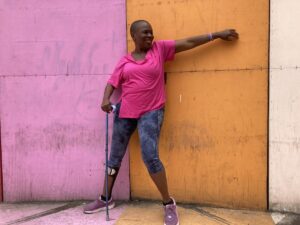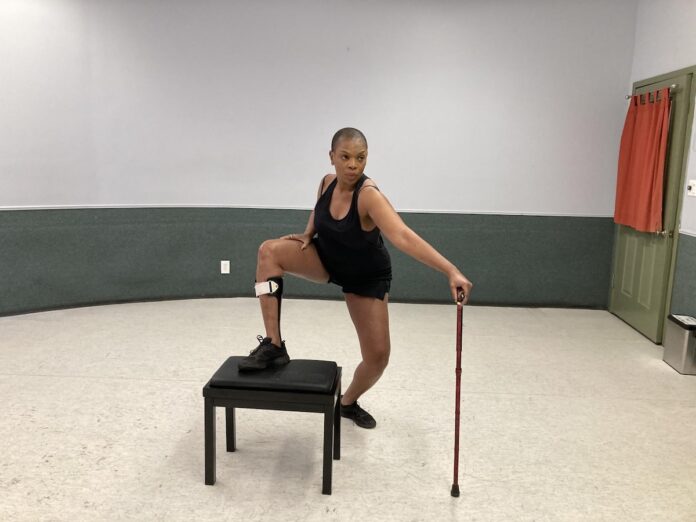As we honor Disability Pride Month, we spotlight Zazel-Chavah O’Garra. Diagnosed with meningioma, a brain tumor, in 2003, Zazel overcame immense challenges during her treatment, including paralysis, cognitive loss, and a speech impediment.
She founded the ZCO/DANCE PROJECT, a space to inspire and showcase the strength of dancers with disabilities, in 2013. We chatted with her about her personal and professional journey, the way she continues to break barriers and redefine life with a disability, and society’s perception of them.
BHM: Can you share with us your journey into the world of dance and the performing arts? What inspired you to choose this path?
Zazel-Chavah O’Garra: I started dancing when my mother realized that I was a hyperactive, mischievous child. She often said, in her West Indian accent, “Zazel walked out of me belly!” She asked my godmother if she knew of any activities she could put me in, and she recommended Ruth Williams Dance Studio, located on 125th and Adam Clayton Powell Blvd in the Theresa Hotel, a landmark building in Harlem. I studied ballet and tap there and fell in love with both.
Ballet captivated me with its structure, technique, and discipline, while tap was exciting as we danced to music by a jazz pianist and drummer. At the end of the year, we performed at Carnegie Hall or Lincoln Center. Wearing costumes and seeing huge audiences in these theaters made me realize I wanted to be in the performing arts. I later left Ruth Williams and went to Bernice Johnson Dancing School, where I met Ben Vereen and Michael Peters.
The intense professionalism at Bernice Johnson led me to audition for the High School of the Performing Arts. Once accepted, I became a ballet major. Entering that school made me live and breathe dance! It was rigorous, competitive, and challenging. Studying dance there led me to Alvin Ailey and the Dance Theater of Harlem. As a scholarship student and apprentice, I focused on becoming a professional dancer.

The Brain Tumor Diagnosis
BHM: Can you walk us through your experience when you were diagnosed with a brain tumor? How did it affect your life and career, especially about your craft?
CO: I had been experiencing symptoms for years: extreme fatigue where I could fall asleep in a minute, a tingling sensation in my right arm, nausea, and headaches. I went to a slew of doctors, had a battery of tests, and they found nothing. Finally, I went to the gynecologist, and she put me on birth control pills, which is what I did. The birth control pills made my head feel like it was exploding, and I started to have weird sensations in my head. I was having partial seizures, but I didn’t know what it was.
Eventually, I went to the emergency room at St. Barnabas Hospital in New Jersey. They tested me and found nothing. As they were discharging me, I mentioned feeling dizzy, so they gave me an MRI. After the MRI, they gave me Xanax and told me to wait for the doctor. When the doctor saw me, she had a sullen look on her face. She said they found a huge mass on my brain, 4 centimeters large! They immediately rushed me to intensive care, and the neurosurgeon came to speak to me, saying I needed immediate surgery. Because of the tumor’s location, they warned me to expect partial paralysis, visual and cognitive deficits, and speech and memory problems.
At that moment, I knew the life I loved would change. However, I didn’t show the doctor or my family any signs of depression. Instead, I declared, “I am a fighter, a warrior woman. God is on my side! I will dance again!”
The Recovery Process
BHM: What was your rehabilitation process like, and how did it influence your perspective on life and dance?
ZCO: I rehabilitated at Kessler Rehab, a beautiful West Orange, New Jersey facility. In rehab, you face the harsh reality of your new life. When you can’t get out of bed, bathe, go to the bathroom, or walk, you feel helpless and dependent on others to help you with basic tasks. They wake you up every morning, get you out of bed, body wash you, and then you’re put in a wheelchair to wait to be moved to the dining room.
I met with several doctors, including a neurosurgeon who once asked if I was suicidal. I responded, “NO, I’m waiting for Macy’s One Day Sale! I always liked shopping. Why would I stop now?” I knew immediately that being among those suffering from brain injuries required staying positive, optimistic, and prayerful. Although my life as a non-disabled dancer was over,
I knew that sitting in a chair with limited mobility couldn’t stop me from experiencing the joy of dance. Even if it were just my eyes and head moving, the passion, conviction, and love of dance for healing came through my soul.
During my recovery from a brain tumor, I faced several specific challenges. When I announced I was a brain tumor survivor, the reactions from people, including friends, were often difficult to handle. One memorable incident involved someone I knew who crossed the street to avoid talking to me. My Caribbean family, although loving and supportive, struggled with how to deal with someone with a disability. One family friend even said, “I thought you were going to be a star, and look at you now!”
To overcome these challenges, I focused on turning setbacks into comebacks. I sought guidance and support through therapy and found immense inspiration in a loving friend who, after a car accident, became a quadriplegic. He taught me to love the arts and explore myself, no matter what happens. His perspective and strength helped me navigate my journey and find my path forward.
Creating a Way to Dance Again
BHM: What inspired you to start the Zazel-Chavah O’Garra Dance Project (ZCODP)?
ZCO: I founded ZCODP as a testament to my journey of rebirth and resilience, finding profound healing and joy through dance despite challenges. Our mission at ZCODP is to create compelling performances that blend wit, soul, intelligence, and power while telling captivating narratives. We are committed to promoting the integration and inclusion of individuals with disabilities in dance and society.
We aim to present fresh, exhilarating, thought-provoking contemporary dance experiences to a wide audience. ZCO/DANCE PROJECT derives from my birth name, Zazel-Chavah (‘Chavah’ meaning ‘living one’), symbolizing the essence of life and the creative power to share that vitality with others, a name given to me by my father.
BHM: What strengths and perspectives do ZCO/DANCE PROJECT dancers bring to your company?
ZCO: Our dancers contribute their passion, life experiences, and resilience. One dancer, a cancer survivor who uses a wheelchair, powerfully expresses herself through dance. She lifts her leg from the chair, performing pulsating, sensual movements to the rhythm of drums, demonstrating to the audience that nothing can stop her from showcasing the joy and artistry of dance.
At ZCODP, we dance just like any other dance company, incorporating a variety of genres, including modern, jazz, ballet, African dance, and now spoken word. We collaborate with renowned choreographers who treat our dancers as artists, not differently abled individuals.
When we take the stage, we aim for the audience to see us purely as performing artists.
BHM: What does Disability Pride Month mean to you, and how do you celebrate it both as the owner of your dance company and in your personal life?
ZCO: I celebrate Disability Pride Month by raising awareness and celebrating the visibility, value, and respect people with disabilities deserve. Everyone needs to recognize and rejoice in our talents. I embrace my disability with pride and proudly claim it.






